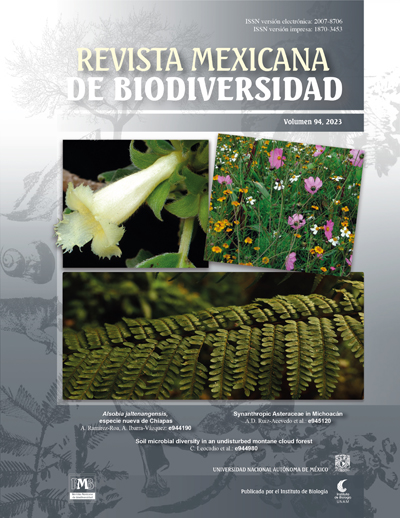Daily activity of threatened canopy mammals in a private protected natural area of tropical southeastern Mexico
DOI:
https://doi.org/10.22201/ib.20078706e.2023.94.4951Keywords:
Activity overlap, Arboreal mammalsAbstract
Private conservation areas (PCA) are a complementary resource that can be used to favor the conservation of mammals in tropical regions of the world. However, their reduced extent can exert a differential influence on the behavior of the species present, and ultimately affect their coexistence. We investigated the daily activity patterns of canopy mammals during the rainy season of 2016 in a 100 ha PCA in tropical forest. To record activity, 11 camera traps were set up in trees at 15 m above ground level. Sciurus deppei was the only diurnal mammal recorded. Potos flavus was more active around midnight, while Caluromys derbianus and Coendou mexicanus were active before (21:00 to 23:00 h) and after midnight (01:00 to 04:00 h). Tamandua mexicana and Didelphis marsupialis were active throughout the night. The nocturnal mammals showed great overlap in their hours of activity. Overall, there was no difference in activity patterns of canopy mammals in this small PCA compared to those reported in larger protected natural areas. The highest number of records occurred in the tallest trees located in the highest and best-conserved parts of the study area, suggesting the importance of forested PCA to the conservation of canopy mammals.
References
References
Altieri, M. A., & Toledo, V. M. (2011). The agroecological revolution in Latin America: rescuing nature, ensuring food sovereignty and empowering peasants. Journal of Peasant Studies, 38, 587–612. https://doi.org/10.1080/03066150.2011.582947
Astiazarán-Azcárraga, A., Gallina-Tessaro, S., & Delfin-Alfonso, C. A. (2020). Activity patterns of arboreal mammals in a tropical rain forest in México. Therya, 11, 225–231. https://doi.org/10.12933/therya-20-779
Charles-Dominique, P., Atramentowicz, M., Charles-Dominique, M., Gerard, H., Hladik, A., Hladik, C. M., & Prévost, M.-F. (1981). Les mammifères frugivores arboricoles nocturnes d’une forêt guyanaise: inter-relations plantes-animaux. Revue d'Écologie (La Terre et la Vie), 35, 341–436.
https ://hal.science/hal-03533285
Diario Oficial de la Federación (2019). Modificación del Anexo Normativo III, Lista de especies en riesgo de la Norma Oficial Mexicana NOM-059-SEMARNAT-2010, Protección ambiental-Especies nativas de México de flora y fauna silvestres-Categorías de riesgo y especificaciones para su inclusión, exclusión o cambio-Lista de especies en riesgo, publicada el 30 de diciembre de 2010.
Estrada, A. & Coates-Estrada R. (1985). A preliminary study of resource overlap between howling monkeys (Alouatta palliata) and other arboreal mammals in the tropical rain forest of Los Tuxtlas, Mexico. American Journal of Primatology, 9, 27–37. https://doi.org/10.1002/ajp.1350090104
Frey, S., Fisher, J. T., Burton, A. C., & Volpe, J. P. (2017). Investigating animal activity patterns and temporal niche partitioning using camera-trap data: challenges and opportunities. Remote Sensing in Ecology and Conservation, 3, 123–132. https://doi.org/10.1002/rse2.60
Gallina, S., & González-Romero, A. (2018). The conservation of medium-sized mammals in two private ecological reserves of Veracruz, Mexico. Revista Mexicana de Biodiversidad, 89, 1245–1254. https://doi.org/10.22201/ib.20078706e.2018.4.2476
Gaston, K. J., Jackson, S. E., Cantú-Salazar, L., & Cruz-Piñon, G. (2008). The ecological performance of protected areas. Annual Review of Ecology, Evolution, and Systematics, 39, 93–113. https://doi.org/10.1146/annurev.ecolsys.39.110707.173529
Goodwin, G. G. (1954). Mammals from Mexico collected by Marian Martin for the American Museum of Natural History. American Museum Novitates, 1689, 1–16. http://hdl.handle.net/2246/4908
Halffter, G. (2005). Towards a culture of biodiversity conservation. Acta Zoológica Mexicana (N.S.), 21, 133–153. https://doi.org/10.21829/azm.2005.2121991
Haysom, J. K., Deere, N. J., Wearn, O. R., Mahyudin, A., Jami, J., Reynolds, G. et al. (2021). Life in the canopy: using camera-traps to inventory arboreal rainforest mammals in Borneo. Frontiers in Forests and Global Change, 4, 673071. https://doi.org/10.3389/ffgc.2021.673071
Hernández-Huerta, A. (1992). Los carnívoros y sus perspectivas de conservación en las áreas protegidas de México. Acta Zoológica Mexicana (N.S.), 54, 1–23. https://doi.org/10.21829/azm.1992.49541681
Hernández Hernández, J. C., Chávez, C., & List, R. (2018). Diversidad y patrones de actividad de mamíferos medianos y grandes en la Reserva de la Biosfera La Encrucijada, Chiapas, México. Revista de Biología Tropical, 66, 634–646. https://doi.org/10.15517/rbt.v66i2.33395
Holmes, G. (2013). What role do private protected areas have in conserving global biodiversity? Sustainability Research Institute (SRI) working papers.
Laurance, W. F., Sayer, J., & Cassman, K. G. (2014). Agricultural expansion and its impacts on tropical nature. Trends in Ecology & Evolution, 29, 107–116. https://doi.org/10.1016/j.tree.2013.12.001
Leija-Loredo, E. G., & Pavón, N. P. (2017). The northernmost tropical rain forest of the Americas: Endangered by agriculture expansion. Tropical Ecology, 58, 641–652.
Mella-Méndez, I., Flores-Peredo, R., Bolívar-Cimé, B., & Vázquez-Domínguez, G. (2019). Effect of free-ranging dogs and cats on medium-sized wild mammal assemblages in urban protected areas of a Mexican city. Wildlife Research, 46, 669–678. https://doi.org/10.1071/WR19074
Meredith, M., & Ridout, M. (2014). Overview of the overlap package. R Project. https://CRAN.R-project.org/package=overlap
Montgomery, G. (1985). Movements, foraging and food habits of the four extant species of neotropical vermilinguas(Mammalia; Myrmecophagidae). In M. GG (Ed.), The evolution and ecology of armadillos, sloths, and vermilinguas. (pp. 365–377). Washington D.C.: Smithsonian Institution Press.
Mugerwa, B., du Preez, B., Tallents, L. A., Loveridge, A. J., & Macdonald, D. W. (2017). Increased foraging success or competitor avoidance? Diel activity of sympatric large carnivores. Journal of Mammalogy, 98, 1443–1452. https://doi.org/10.1093/jmammal/gyx090
Nakamura, A., Kitching, R. L., Cao, M., Creedy T. J., Fayle, T. M., Freiberg, M. et al. (2017). Forests and their canopies: achievements and horizons in canopy science. Trends in Ecology & Evolution, 32, 438–451. https://doi.org/10.1016/j.tree.2017.02.020
Oliveira-Santos, L. G. R., Tortato, M. A., & Graipel, M. E. (2008). Activity pattern of Atlantic Forest small arboreal mammals as revealed by camera traps. Journal of Tropical Ecology, 24, 563–567. https://doi.org/10.1017/S0266467408005324
Ortiz-Lozada, L., Pelayo-Martinez, J., Mota-Vargas, C., Demeneghi-Calatayud, A. P., & Sosa, V. J. (2017). Absence of large and presence of medium-sized mammal species of conservation concern in a privately protected area of rain forest in southeastern Mexico. Tropical Conservation Science, 10, 1–13. https://doi.org/10.1177/1940082917738093
R Core Team. (2022). R: A language and environment for statistical computing. Vienna, Austria: R Foundation for Statistical Computing. https://www.R-project.org/
Ramírez-Pulido, J., Arroyo-Cabrales, J., & Castro-Campillo, A. (2005). Estado actual y relación nomenclatural de los mamíferos terrestres de México. Acta Zoológica Mexicana (n.s.), 21, 21–82. https://doi.org/10.21829/azm.2005.2112008
Ridout, M. S., & Linkie, M. (2009). Estimating overlap of daily activity patterns from Camera trap data. Journal of Agricultural Biological and Environmental Statistics, 14, 322–337. https://link.springer.com/article/10.1198/jabes.2009.08038
Santos-Hernández, A. F., Monterroso-Rivas, A. I., Granados-Sánchez, D., Villanueva-Morales, A., & Santacruz-Carrillo, M. (2021). Projections for Mexico's tropical rainforests considering ecological niche and climate change. Forests, 12. 119 https://doi.org/10.3390/f12020119
Schmid, F., & Schmidt, A. (2006). Nonparametric estimation of the coefficient of overlapping - theory and empirical application. Computational Statistics & Data Analysis, 50, 1583–1596. https://doi.org/10.1016/j.csda.2005.01.014
Stolton, S., Redford, K. H., & Dudley, N. (2014). The futures of privately protected areas Retrieved from https://portals.iucn.org/library/sites/library/files/documents/PATRS-001.pdf
UNEP-WCMC, & IUCN (2023), Protected planet: the World Database on Protected Areas (WDPA) and World Database on Other Effective Area-based Conservation Measures (WD-OECM) [Online], February 2023, Cambridge, UK: UNEP-WCMC and IUCN. Available at: www.protectedplanet.net
Volenec, Z. M., & Dobson, A. P. (2020). Conservation value of small reserves. Conservation Biology, 34, 66–79. https://doi.org/10.1111/cobi.13308
Voss, R. S. (2011). Revisionary notes on neotropical porcupines (Rodentia: Erethizontidae) 3. An annotated checklist of the species of Coendou Lacépède, 1799. American Museum Novitates, 3720, 1–36. http://hdl.handle.net/2246/6121
Wong, B. B. M., & Candolin, U. (2015). Behavioral responses to changing environments. Behavioral Ecology, 26, 665–673. https://doi.org/10.1093/beheco/aru183




